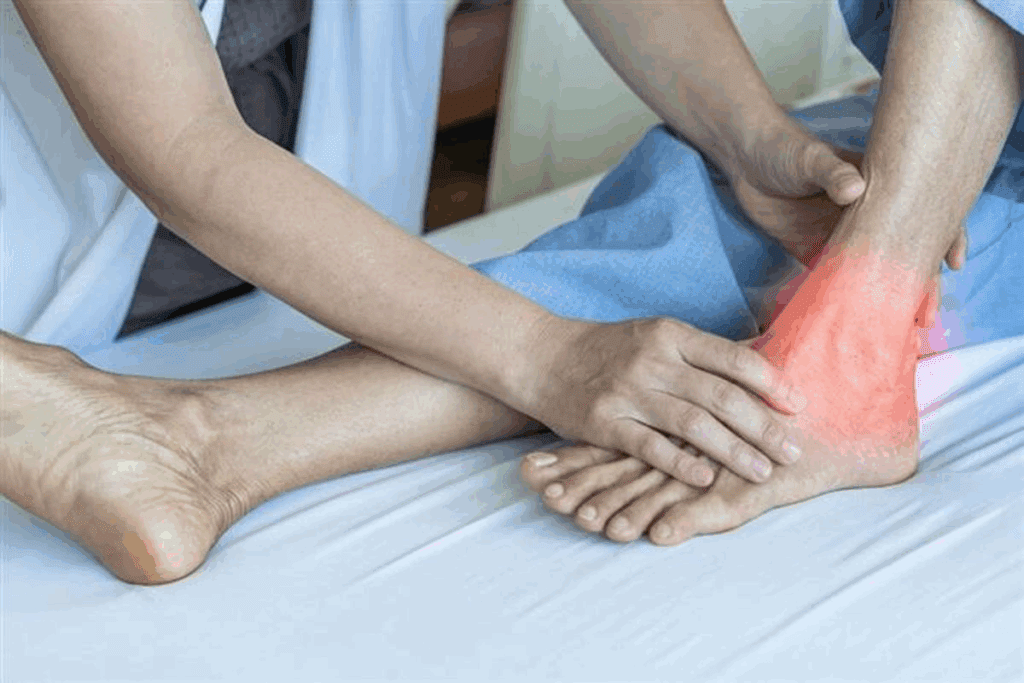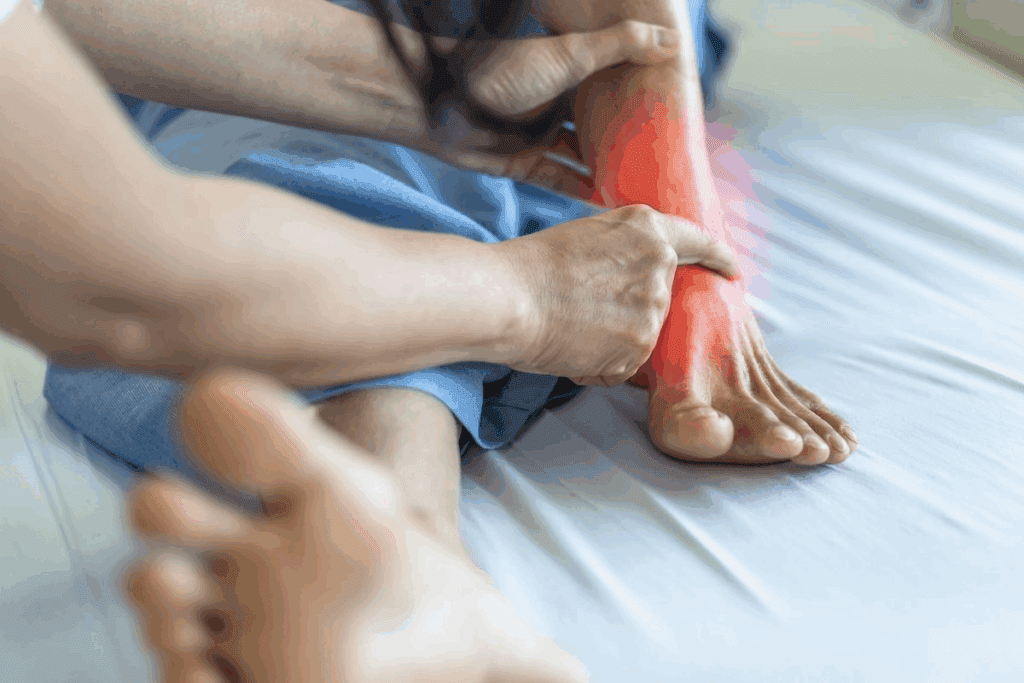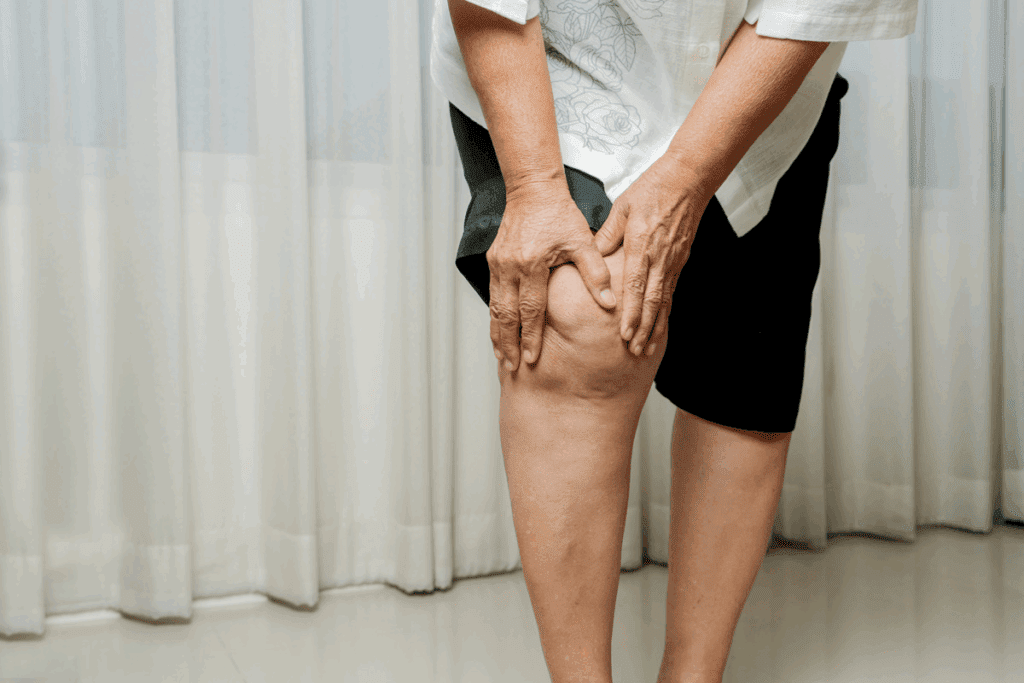Last Updated on November 4, 2025 by mcelik

Did you know that chronic stress can cause more than just mental tiredness? It can also lead to tendonitis, a condition where tendons get inflamed and hurt. Tendons connect muscles to bones and are key for movement and stability. The Shocking link between your mental health and pain. Stress-Induced Tendonitis is Finally Exposed here.
When stress is ongoing, it can cause chronic muscle tension and repetitive motion injuries. This makes tendonitis more likely.
It’s important to understand how stress and tendonitis are connected. This knowledge helps in preventing and managing the condition. By learning about stress-induced tendonitis, people can use stress management techniques to lower their risk.

Stress, whether it’s physical or mental, greatly affects our tendons. The link between stress and tendons is complex. It involves many factors that can cause tendonitis.
Physical and mental stress both harm tendon health. Physical stress comes from doing the same thing over and over, or getting hurt. Mental stress can make muscles tight, change how we move, and make pain worse.
Key Stress Factors Affecting Tendon Health:
Stress affects our muscles and bones in many ways. It mainly does this by releasing cortisol, a hormone that helps us react quickly. High levels of cortisol can cause tendons to get inflamed, making them more likely to get hurt or wear down.
| Effect of Stress | Impact on Musculoskeletal System |
| Increased Cortisol Levels | Enhanced inflammation in tendons |
| Muscle Tension | Altered movement patterns and increased strain on tendons |
| Poor Posture | Increased loading on tendons, potentially leading to overuse injuries |
It’s important to know how stress affects tendons to prevent and treat problems. By tackling both physical and mental stress, we can lower the chance of tendonitis and other muscle and bone issues.

Tendonitis is a condition that affects the tendons. Tendons are tissues that connect muscles to bones. When they become inflamed, it can cause pain and make it hard to move.
Tendonitis is when tendons get inflamed, often from repetitive strain or overuse. It can happen to any tendon in the body. This leads to pain and discomfort in the affected area. It’s common in athletes and people who do the same motion over and over.
Several things can cause tendonitis. These include:
The table below shows the common causes of tendonitis and how they affect tendons:
| Cause | Description | Effect on Tendons |
| Repetitive Motion | Activities involving repetitive movements | Strains tendons, leading to inflammation |
| Age | Natural decline in tendon health with age | Increased susceptibility to tendonitis |
| Poor Posture | Incorrect posture putting strain on tendons | Contributes to tendon inflammation |
Understanding stress-induced tendonitis is key to finding treatments. This condition happens when stress affects our body’s health, leading to tendon problems.
Cortisol, known as the “stress hormone,” is important in our stress response. High levels of cortisol can harm tendon tissue, causing inflammation and damage. Long-term stress means our body keeps making cortisol, which hurts our tendon repair skills.
Cortisol affects tendons in many ways. It can:
Long-term stress causes ongoing inflammation, making tendonitis worse. The inflammation process releases harmful chemicals that damage tissues. This can weaken tendons, making them more prone to injury and inflammation.
Important parts of the inflammation include:
Muscle tension is a big factor in stress-induced tendonitis. When muscles are tight from stress, it puts strain on tendons. This strain can cause tiny tears in tendons, leading to pain and inflammation.
“Muscle tension acts as a catalyst for tendon strain, creating a cycle of tension and pain that can be challenging to break without proper intervention.”
To fight muscle tension’s impact on tendons, managing stress and doing exercises that relax muscles and improve tendon health is vital.
Chronic muscle tension, often caused by stress, plays a big role in tendonitis. When muscles stay tense for a long time, it can cause inflammation and irritation in the tendons. This leads to tendonitis.
Stress-related muscle guarding is a way muscles tighten to protect the body. While it’s meant to be protective, it can cause long-term muscle tension. This tension can strain and inflame the tendons.
Key factors involved in stress-related muscle guarding include:
The cycle of tension and pain is a vicious cycle. Muscle tension causes pain, and pain makes muscle tension worse. This cycle can make tendonitis worse and harder to treat.
| Factors Contributing to the Cycle | Effects on Tendonitis |
| Muscle Tension | Increased strain on tendons |
| Pain | Reduced mobility and increased guarding |
| Stress | Exacerbation of muscle tension and pain |
It’s important to break this cycle to manage and prevent tendonitis. Physical therapy, relaxation exercises, and stress management can help. They can reduce muscle tension and lower the risk of tendonitis.
Stress and repetitive motion injuries are closely linked, mainly in work settings. These injuries happen when doing the same thing over and over again strains tendons. This leads to inflammation and pain.
Workplace stress plays a big role in these injuries. When people are stressed, their muscles get tight. This makes the strain from repetitive actions worse.
Workplace stress is a big factor in repetitive strain disorders. High stress levels can make muscles tense. This tension increases the risk of injury from repetitive actions.
Stress makes the negative effects of repetitive motions worse on tendons in several ways. The body’s stress response, known as the “fight or flight” response, tightens muscles. This tension makes repetitive movements more straining.
It’s important to understand how stress and repetitive motion injuries are connected. This knowledge helps in creating effective prevention and treatment plans. By tackling both physical and mental aspects of these injuries, we can reduce their occurrence and impact.
Stress can really change how we stand, which can hurt our tendons. When stressed, our muscles tighten, leading to bad posture. Knowing this link is key to avoiding tendonitis.
Long-term stress makes muscles tight, mainly in the neck, shoulders, and upper back. This tightness makes us slouch or lean forward. These changes can strain tendons, raising the chance of inflammation and injury.
Poor posture changes how tendons handle stress during daily tasks. For example, leaning forward strains neck and shoulder tendons. Slouching affects upper back and shoulder tendons. This uneven loading can cause tendonitis.
| Postural Change | Effect on Tendons | Common Symptoms |
| Forward Head Posture | Increased strain on neck and shoulder tendons | Neck pain, shoulder stiffness |
| Slouched Back | Additional stress on upper back and shoulder tendons | Upper back pain, shoulder discomfort |
| Uneven Weight Distribution | Altered loading on lower extremity tendons | Knee pain, ankle stiffness |
Good posture is key to avoiding tendonitis, even with chronic stress. Using ergonomic practices, stretching, and strengthening can help. These actions reduce the harm of bad posture on tendons.
It’s key to know the signs of stress-induced tendonitis to manage and recover well. This condition shows up in different ways, both in how you feel and in your body. Spotting these signs early is important for quick action.
The physical signs of stress-induced tendonitis include:
These symptoms can get worse with more activity. Early recognition helps avoid more harm.
Stress-induced tendonitis affects your mind too. You might feel:
Seeing these mental signs is key for treating the whole you. Managing stress is just as important as treating the body.
Knowing when to see a doctor is vital. If you notice:
It’s time to talk to a healthcare expert. Early diagnosis and treatment can make a big difference.
Stress can lead to tendonitis in many parts of the body. This condition causes pain and discomfort. It often happens because of both physical and mental stress.
The neck and shoulders are often hit by stress-induced tendonitis. This area gets tense from bad posture, repetitive actions, and stress. It can lead to pain, stiffness, and trouble moving.
For more info, check out Hospital for Special Surgery’s resource on tendonitis.
Stress can also cause tendonitis in the wrists and hands. This is often due to repetitive strain from work or hobbies. It results in pain, swelling, and less function in the hand or wrist.
Stress can also affect the lower legs, including the Achilles and patellar tendons. Running, jumping, or repetitive strain can worsen this condition when stressed.
| Region | Common Causes | Symptoms |
| Neck and Shoulder | Poor posture, repetitive movements, stress-related muscle guarding | Pain, stiffness, limited mobility |
| Wrist and Hand | Repetitive strain injuries, workplace activities | Pain, swelling, reduced functionality |
| Lower Extremity | Running, jumping, repetitive strain | Pain, swelling, reduced mobility |
Knowing which areas stress can harm is key to preventing and treating tendonitis. By understanding these areas, we can take steps to protect our tendons from stress.
Figuring out if tendonitis is caused by stress takes a detailed look. This careful process helps find the right treatment.
The first step is talking to the patient and doing a physical check. Doctors look at symptoms, lifestyle, and stress factors. They check for things like repetitive actions or high stress.
Key parts of the check-up are:
This mix helps doctors understand what’s going on and why.
It’s hard to tell if tendonitis is from stress or not. Doctors need to know the patient’s symptoms and history well.
Signs that might point to stress-induced tendonitis are:
Getting the diagnosis right is key for good treatment. Knowing stress plays a part helps doctors treat both the body and mind.
It’s important to know the medical treatments for stress-induced tendonitis. This condition needs a treatment plan that tackles symptoms and causes. This helps in managing and recovering from the condition.
Medicines are key in treating stress-induced tendonitis. Common medicines include:
These medicines help ease symptoms. This makes it easier for patients to do physical therapy and other rehab programs.
Physical therapy is vital in treating stress-induced tendonitis. It includes:
A physical therapist can create a program that fits the individual’s needs. This helps in recovery and prevents future injuries.
For cases that don’t get better with usual treatments, advanced options are considered. These include:
| Treatment | Description | Benefits |
| Platelet-rich plasma (PRP) therapy | Injection of platelet-rich plasma to stimulate tendon healing | Promotes tissue repair and regeneration |
| Tendon fenestration | A procedure involving multiple needle insertions to stimulate healing | Enhances tendon repair and reduces pain |
| Shockwave therapy | Application of high-energy shockwaves to promote tendon healing | Stimulates repair and reduces inflammation |
These treatments aim to help the tendon heal and lessen symptoms in patients with stress-induced tendonitis.
Effective treatment of stress-induced tendonitis often needs a mix of these methods. The approach should be tailored to the individual’s specific condition and needs.
Stress management is key to preventing tendonitis and keeping muscles healthy. It helps lower the risk of tendonitis by reducing stress’s negative effects on the body.
Mindfulness and meditation are great for managing stress. They help you notice your thoughts and body feelings better. This way, you can handle stressors more effectively.
Studies show that these practices can lower cortisol, relax muscles, and boost well-being. Even short sessions of mindfulness and meditation can greatly reduce stress and improve tendon health.
Deep breathing is another effective way to manage stress. It calms the nervous system, relaxes muscles, and lowers stress. You can do deep breathing anywhere, making it easy to use all day.
Research proves that deep breathing can lower cortisol, reduce inflammation, and improve heart rate variability. These benefits help lower the risk of tendonitis. Adding deep breathing to your daily routine can make you more resilient to stress.
Cognitive behavioral therapy (CBT) is a psychological method to manage stress. It helps change negative thoughts and behaviors. CBT is great for reducing stress-related muscle tension and guarding, which can lead to tendonitis.
CBT helps you identify and challenge negative thoughts. This can lower your stress levels and improve how you cope with challenges. Using CBT with mindfulness and deep breathing can offer a complete approach to managing stress and preventing tendonitis.
| Stress Management Technique | Description | Benefits |
| Mindfulness and Meditation | Practices that increase awareness of thoughts and bodily sensations | Reduces cortisol, decreases muscle tension, improves well-being |
| Deep Breathing Exercises | Slow, deliberate breathing to calm the nervous system | Lowers cortisol, reduces inflammation, improves heart rate variability |
| Cognitive Behavioral Therapy | Psychological approach to change negative thought patterns | Reduces stress levels, improves coping mechanisms, decreases muscle tension |
Physical strategies are key in stopping and handling tendonitis from stress. Adding certain physical methods to your daily life can lower tendonitis risk and ease symptoms if you have it.
Ergonomic practices are vital in easing tendon strain, mainly in work settings. Making sure your workspace supports good posture can prevent tendonitis. This means adjusting chair heights, monitor angles, and keyboard spots to reduce muscle and tendon strain.
Key Ergonomic Adjustments:
Regular stretching and strengthening can boost tendon health. It makes muscles stronger and more flexible. Exercises that target the shoulders, wrists, and knees are most helpful.
| Exercise | Area Targeted | Benefit |
| Shoulder Rolls | Shoulders | Relieves tension |
| Wrist Extensions | Wrists | Improves flexibility |
| Knee Squats | Knees | Strengthens surrounding muscles |
Yoga and gentle movement therapies are great for managing tendonitis from stress. They help lower stress and boost flexibility and strength.
Benefits of Yoga for Tendonitis:
By adding these physical methods to your daily routine, you can prevent and manage tendonitis from stress. This improves your overall life quality.
Understanding the mind-body connection is key to seeing how stress affects tendons. Stress and physical health are linked, impacting the musculoskeletal system. This connection is complex.
Stress can cause inflammation and slow down tendon healing. Studies show chronic stress weakens the immune system. This makes it harder for tendons to repair. A study on the National Center for Biotechnology Information website shows stress’s impact on musculoskeletal health.
The immune system is vital for tendon repair. Stress can weaken it, slowing healing. Cortisol, a stress hormone, can also harm the immune system.
For tendons to heal well, a strong immune response is needed. Stress management can help keep the immune system strong. This supports tendon health.
| Stress Factor | Impact on Tendon Health | Management Technique |
| Chronic Stress | Suppresses immune function, delaying healing | Mindfulness and meditation |
| High Cortisol Levels | Inflammation and tissue damage | Deep breathing exercises |
| Muscle Tension | Tendon strain and injury | Stretching and strengthening exercises |
Holistic tendonitis management looks at both physical and mental health. Yoga, mindfulness, and cognitive behavioral therapy can help manage stress. They promote tendon health.
“The mind and body are not separate entities; they are intimately connected, and each influences the other.”
— A principle of holistic health
Adding holistic practices to treatment plans can improve recovery. It can also prevent future tendon injuries. By focusing on stress and overall well-being, people can better their tendon health. This reduces the risk of tendonitis.
Recovering from stress-induced tendonitis needs a full plan. This plan must tackle both the stress and the tendonitis. We’ve looked at how stress and tendon health are linked. We’ve seen how ongoing stress can make tendonitis worse.
To manage stress-induced tendonitis, you must treat the symptoms and manage stress. This includes mindfulness, physical therapy, and making your workspace better. These steps help lessen tendon strain.
By focusing on both stress and tendonitis, you can fully recover. This approach boosts your overall health and helps your body heal better.
For the best recovery, use a mix of stress management, physical therapy, and lifestyle changes. This all-encompassing strategy is vital for dealing with stress-induced tendonitis. It leads to lasting relief.
Stress-induced tendonitis is when tendons get inflamed and irritated. This happens because of stress, whether it’s physical or mental. It shows how stress affects our muscles and tendons.
Stress makes cortisol levels go up, which can cause inflammation. It also tightens muscles, putting more strain on tendons. Long-term stress can make tendonitis worse.
You might feel pain, stiffness, and swelling in your tendons. You might also feel more anxious or stressed because of the pain.
The neck and shoulders, wrists and hands, and lower legs are often affected. These areas get stressed and strained a lot.
Doctors will check your history, do a physical exam, and might use imaging to see tendon damage. They want to make sure it’s not something else.
Doctors might give you medicine to reduce inflammation. They might also suggest physical therapy, like exercises to stretch and strengthen. Sometimes, they might use injections to help.
Yes, managing stress can help. Mindfulness, deep breathing, and other strategies can reduce stress and prevent tendonitis.
Using ergonomic practices and doing exercises can help. Gentle movements, like yoga, can also reduce strain on tendons and improve health.
Stress affects how our body heals and our immune system. Taking care of both our body and mind is key to managing tendonitis.
Yes, you can prevent it by managing stress, using ergonomic tools, exercising regularly, and living a healthy lifestyle.
Cortisol, a stress hormone, can harm tendon tissue. It can lead to inflammation and damage.
Yes, stress can make repetitive motion injuries worse. This is true, for example, in jobs where you do the same thing over and over.
Subscribe to our e-newsletter to stay informed about the latest innovations in the world of health and exclusive offers!